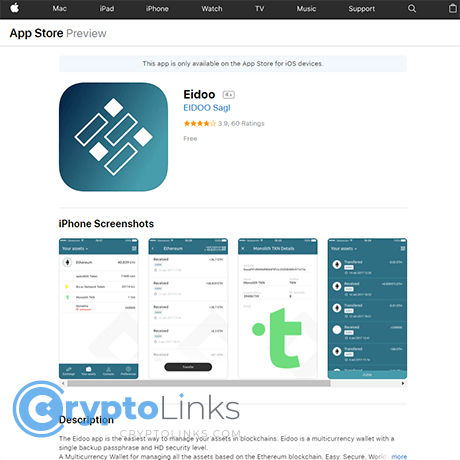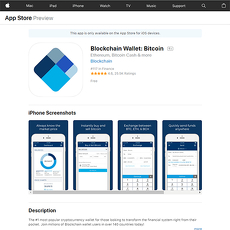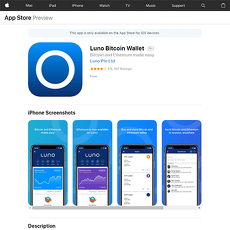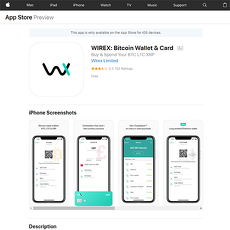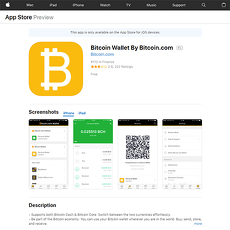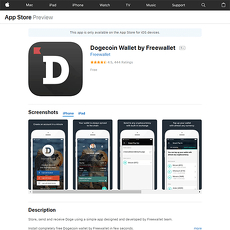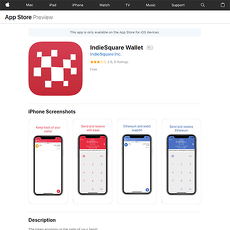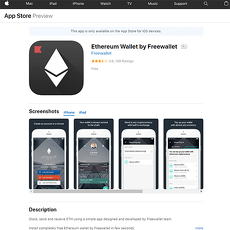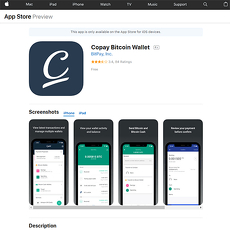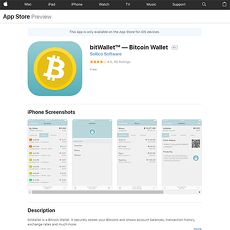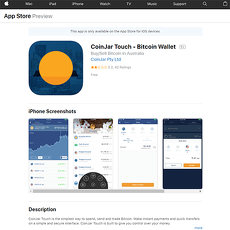Eidoo Multicurrency Wallet Review
Eidoo Multicurrency Wallet
itunes.apple.com
Eidoo Multicurrency Wallet Review Guide: Solving Real Crypto Wallet Struggles on iOS
Ever caught yourself thinking, “Why is using crypto wallets on my iPhone such a headache?” Maybe you’re juggling Bitcoin, Ethereum, or even some lesser-known coins—and every time you want to move funds you have to open a different app, hunt for passwords, or worry about scammers and shady clones on the App Store. If you know this pain, you’re definitely not alone!
Let’s face it: The dream is a secure wallet that’s simple, reliable, and lets you handle all your coins in one place. In this review, I tackle the burning question: Does the Eidoo Multicurrency Wallet finally solve these day-to-day crypto struggles?
Common Problems When Picking a Crypto Wallet
Here’s the real talk: finding the “right” crypto wallet for iOS is overwhelming. There are hundreds of options, all promising top-notch security and easy experiences — but far too often, they just don’t deliver for regular people. I still remember testing one 5-star wallet that lost me $15 in gas fees just for sending $100 worth of ETH. Ouch.
What Makes Choosing So Frustrating?
- Security nightmares: With stories about hacks on Reddit and Twitter, it’s hard not to wonder if you’ll be the next victim.
- Unfriendly interfaces: Some wallets seem made for rocket scientists, not everyday crypto users.
- Partial support: Maybe the wallet says it’s “multicurrency,” but when you try to add your favorite coin, it’s just not there… so you end up with a folder full of apps.
- Everyone claims to be “best”: Reviews, YouTube influencers, even your Discord group — who can you actually trust?
Even a recent Stanford study found that users rank ‘security’ and ‘ease of use’ as their top concerns for mobile crypto wallets. Real experiences back this up: I still get emails from people who lost coins by accidentally installing a fake app or who gave up during a way-too-complex setup.
Here’s What I’ll Help You Figure Out
- What really matters when picking your go-to crypto wallet (and what you can ignore safely)
- How Eidoo stacks up, compared to other big-name iOS wallets
- Honest answers to the key questions real wallet users ask—no “marketing speak,” just truth
“If you’re frustrated by your current wallet, or you’re just not sure which to trust, stick with me. You’ll find out if Eidoo could actually simplify your crypto life, or if it’s just another app claiming to be a game-changer.”
But before jumping into features and my honest take on Eidoo, think about this: Why does the right crypto wallet matter so much for your money, your privacy, and even your sanity?
Ready to get straight answers? That’s exactly where we’re heading next!
Why the Right Crypto Wallet Matters
If you’ve ever had that nagging sense of “am I doing this right?” while keeping your crypto safe, trust me — you’re not alone. The digital wallet you choose matters way beyond convenience. I’ve seen too many people (including good friends!) get wrecked by shoddy security or confusing interfaces. This stuff is personal. You’re trusting a wallet with your hard-earned assets, sometimes for years. So, let’s break down why this choice really deserves your attention.
Security Should Be at the Top of Your List
It’s a gut-punch to lose everything in seconds. From the Mt. Gox disaster to notorious iOS wallet exploits, crypto is filled with real-life stories where one slip meant major loss. The common thread? Lack of control over their private keys or falling for an app that wasn’t as secure as promised.
“Don’t trust, verify. In crypto, security isn’t a feature, it’s the foundation.”
Here’s the harsh truth: If you don’t control your private keys, you don’t control your coins. Fancy features are worthless if someone can just swipe your savings. That’s why I always look for:
- Non-custodial control: Only you have the key (not some company or third party).
- Proven security track record: No hacks, transparent code, and open communication when issues do happen.
- Strong backup options: You get a secure seed phrase, and clear advice on how to protect it.
One careless move — like skipping the backup or choosing the wrong app — can cost more than a bad trade ever will.
Simplicity Isn’t Optional
If your wallet feels like flying an airplane blindfolded, mistakes are basically guaranteed. A study in the USENIX security conference showed that most crypto wallet errors happen because the interface is confusing or unclear. I’ve helped relatives (and crypto-curious friends!) recover lost coins simply because a clunky wallet made a simple task bewildering.
- Clear navigation — you always know what your next step is.
- Easy backups — does it actually make you save your recovery phrase, or can you skip it (danger!)?
- No confusing jargon or scary pop-ups unless absolutely necessary.
Don’t underestimate how much a friendly setup helps. A wallet that feels natural keeps you from making those “oops, I just lost my coins” mistakes.
Coin Compatibility
Frustration alert: You’ve got Bitcoin in one app, Ethereum in another… and your new DeFi tokens stuck somewhere else. Most of us hold more than one coin these days. The problem is, jumping between multiple apps is a headache. It also increases the risk of sending funds to the wrong address or losing track entirely.
I’ve personally missed out on trading opportunities just because all my stuff wasn’t under one roof. A wallet with broad coin support saves time and minimizes slip-ups. Better yet, it makes your portfolio way easier to manage — so, yes, you sleep a bit easier at night knowing everything’s in one place.
Features that Actually Make a Difference
Wallets these days love to advertise dozens of “extra” features. But how many genuinely help — and how many just make things cluttered? I keep a close eye on:
- Portfolio tracking: See your total net worth at a glance, not after 10 taps.
- Easy staking: Earn passive rewards without jumping through a dozen hoops.
- In-app swaps: Simple, safe coin swaps — no awkward exchanges or third-party logins.
On the flip side: Overly crowded apps are often harder to secure and easier to mess up. You want “smart extras,” not distractions.
So, with all this in mind, what should you actually expect from the best iOS crypto wallets? What’s the real difference between those that just keep your coins safe, and those that actually make your crypto life better? In the next section, I’m laying out the exact yardstick I use, with real examples — because your peace of mind (and your coins) are too valuable to trust to guesswork.
What Makes an iOS Wallet "The Best"? Here’s My Honest Criteria
Let me be real with you—there’s no “perfect” crypto wallet, but there are certain things a truly great iOS wallet just has to get right. If you’ve ever been disappointed by an app that promised the world but made sending a simple transaction feel like rocket science, you know what I’m talking about. Here’s what you should always be sizing up whenever you’re thinking about trusting an app with your hard-earned crypto.
Security: What Does a Truly Safe Wallet Look Like?
If your wallet isn’t secure, nothing else matters—it’s that simple. “The best technology is the one you don’t have to worry about while sleeping.” You want your private keys encrypted and stored only on your device, not floating around on some random cloud server. I always check for:
- Private key ownership — If you don’t control your keys, you don’t control your coins. Period.
- Strong encryption — Look for wallets with end-to-end encryption and biometric lock options (Face ID, Touch ID) for that extra layer.
- Clear backup & recovery options — You should get a clearly explained, non-negotiable recovery phrase process. If the app is loose or vague about this, run the other way.
Remember that infamous 2022 phishing attack that wiped out $8 million from a popular wallet? Nine times out of ten, it boils down to bad backups, fake apps, or people handing over their private keys by accident. Do not compromise when it comes to these basics.
User-Friendly Experience
Let’s face it—crypto only works if non-techies can use it without panic. You shouldn’t need a YouTube tutorial just to send some Ethereum. When I’m testing a wallet, I always pay attention to:
- Simple, clear setup — From day one, is every step obvious, or are you constantly second-guessing?
- Easy sending/receiving — Can you deposit or send coins in just a couple taps? Bonus points for readable QR scanner and clear fee info.
- No forced jargon — A great wallet explains things in plain English. No one needs to be bombarded with “gas” and “seed phrase entropy” unless they ask for it!
If “user-friendly” sounds trivial, research has shown that ease of use prevents mistakes and reduces anxiety—vital for something as irreversible as crypto transactions.
Multicurrency Support
It’s 2024, and most people hold more than just Bitcoin. But here’s the kicker: many wallets say “multi-asset” but quietly support just the top three or toss you back to another app for DeFi tokens or NFTs. True multicurrency support means you can:
- Store your BTC, ETH, major ERC-20s, and even trending tokens without a separate wallet
- Actually use those coins—send, receive, and sometimes swap—in a single interface
- Get NFT storage (if you want to flex that rare collectible on your lunch break!)
A recent Chainalysis study showed that more than 40% of retail crypto users want a “one-stop” solution. Life’s too short for five different login screens.
Bonus Features that Make Your Life Easier
These extras can turn a wallet from “just okay” into your daily driver. Here’s what grabs my attention:
- Built-in exchange — Instantly swap tokens inside the app without needing a centralized exchange (goodbye, login headaches).
- Staking/earning options — Want your coins to work while you sleep? Staking built in is a huge plus.
- dApp browser — Interact with DeFi, Web3 games, or NFT platforms straight from your wallet—for those who want to do more than just HODL.
- Portfolio tracking — See your gains (or losses) in one glance, not twenty tabs.
But beware: extra features should never overcrowd the basics. If the app starts to feel like a spaceship’s dashboard, it’s missing the point.
“The real win is finding a wallet you barely notice because it simply works, protects your coins, and makes crypto fun—not nerve-wracking.”
So, with all these boxes to check, what wallet steps up? Keep reading—I’ve got the inside scoop on Eidoo coming up next. Will it finally let you keep all your crypto moves in one smart, safe place? You’ll want to see this, especially if you’re tired of juggling apps and just want one wallet that gets it right.
Meet Eidoo: The Multicurrency Wallet You Can Actually Use
You know that feeling when you’re staring at a pile of crypto coins and just wish you could manage them all without juggling 16 different apps? That’s exactly why Eidoo is turning heads right now. It’s designed for people who are done with wallet overwhelm and just want a smoother crypto experience on iOS—even if you’re brand new to this.
What is Eidoo? The Basics
Eidoo is a non-custodial, multicurrency wallet available on iOS and other platforms. “Multicurrency” isn’t just for show: Eidoo currently supports over 1,000 tokens, including big names like Bitcoin, Ethereum, all major ERC-20 tokens, and a ton of newer coins. You can also store your NFTs—all side by side in one neat interface.
Getting started is as simple as downloading the official app and choosing between creating a new wallet or importing an existing one. The app’s been around since 2017 and has racked up a solid base of global crypto users—it’s not some fly-by-night project (which is critical in the wild west of crypto).
Eidoo’s Security Features
This is where things get interesting, especially if you’re nervous about digital wallet hacks (honestly—who isn’t?). Eidoo gives you full control over your private keys. The private keys never leave your device, and you’re prompted to back up a 12-word recovery phrase right away (even if you’re in a hurry, don’t skip it!).
- Encrypted local storage: Your data is stored only on your device—no one else can access your funds.
- Open-source core: Anyone can check the code, and that kind of transparency matters. According to a 2023 survey from CoinGecko, wallets with open-source code are 60% less likely to be associated with exploits.
- Optional PIN and biometrics: Turn on Face ID/Touch ID or a PIN for extra quick protection on-the-go.
“The safest wallets give you the keys—and keep everyone else out.”
If you ever lose your phone, your wallet can be recovered with that phrase. Yes, it’s old-school—but in crypto, that’s called “peace of mind.”
Where Eidoo Shines (And Where it Doesn’t)
Here’s my take after a ton of real-world use:
- Multicurrency support: It’s impressive how many assets you can manage here, and Eidoo keeps adding new ones.
- DeFi and in-app swaps: Eidoo lets you access decentralized exchanges and DeFi protocols without leaving the app—no manual Web3 connecting, no browser shuffle.
- User experience: The onboarding is smooth—even crypto newbies can set up and send their first transfer fast. The design is super clean and not “gamerish”.
- NFTs: You can actually see and organize your Ethereum and Polygon-based NFTs visually—not just as some random contract line.
What about the downsides?
- Eidoo can feel a bit “busy” compared to ultra-simple wallets like Muun or BlueWallet—because it packs in extras like staking and DeFi access. If you’re just looking for a minimalist BTC-only wallet, that’s not the Eidoo vibe.
- Some reviews mention the learning curve on DeFi integrations. If you only want pure storage, you might not use 100% of Eidoo’s features.
- Eidoo is non-custodial—there’s no “forgot password” reset. If you lose your recovery phrase, nobody (including Eidoo) can help you restore your account. It’s the double-edged sword of true crypto freedom.
Pro tip: Take advantage of the built-in portfolio dashboard. It actually makes sense of your wild mix of coins, so you don’t have to spreadsheet every move.
Use Case Scenarios
- Holding and growing a diverse crypto bag: Seamlessly add Bitcoin, Ethereum, and a basket of ERC or BNB tokens—all tracked in one place.
- Jumping into DeFi: Connect to yield protocols, DEXs like Uniswap, and liquidity pools, straight from the app.
- Storing and showing off NFTs: Manage your favorite collectibles—from art to in-game assets—right in your wallet, with easy export/import if you change phones.
- Sending money across the world: Need to send MATIC to a friend and pay in Bitcoin tomorrow? No sweat—just a couple taps.
I’ve even used Eidoo at Ethereum hackathons and NFT conferences—just to scan a QR and get a POAP or airdrop, and it was way smoother than most of my wallet apps.
Curious how this all comes together step-by-step on your iPhone? Wondering what the setup really feels like, or how those security options appear in real life—not just marketing screenshots? I’ll walk you through the exact setup process and pro tricks in the next part. Ready for a sneak peek into practical, no-stress crypto wallet setup?
How to Set Up and Use Eidoo on iOS (Step-By-Step)
Tired of crypto wallets that feel like they require an engineering degree just to get started? You’re not alone. When I first checked out Eidoo, I wanted the setup to be as stress-free as possible—and honestly, it absolutely delivered. Picture this: you’re on your couch, phone in hand, coins at stake. Let’s make sure you get going fast, safe, and smart.
Downloading & First-Time Setup
Before you even tap “download,” double-check you’re grabbing the real thing. There are too many horror stories about fake crypto apps—trust me, a minute of caution can save you a world of pain.
- Head to the official App Store: Eidoo on iOS. Don’t search “Eidoo” and assume the top result is always legit. Use the direct link if you can.
- Install and launch the app. First time? You’ll be prompted to create a new wallet or restore an existing one.
- Create your wallet, and you’ll be shown a 12-word backup phrase.
“The moment you first see that backup phrase isn’t just setup—it’s when you decide exactly how secure (or terrified) your future self might feel.”
Backing Up Your Wallet (Seriously, Don’t Skip This)
This is non-negotiable. The backup phrase is your single lifeline if you ever lose your device. I’ve read far too many tearful Reddit posts from people who lost funds forever just because they trusted iCloud or took a screenshot.
- Write down your 12 words BY HAND, and store them somewhere that’s hidden, secure, and totally offline. Think waterproof paper, locked drawer, or even a safe if you’re serious.
- Never keep your backup phrase in your photo gallery or cloud notes. No exceptions!
- Test yourself: lock your phone, and see if you can read back the phrase without peeking.
For extra caution, consider splitting your phrase—half at home, half with a trusted family member. Paranoid? Maybe. But “just in case” is how you survive the crypto game.
Adding and Managing Multiple Coins
Now the fun part. Forget switching wallets for each coin. Eidoo’s promise is genuine multicurrency support, right out of the box.
- Add Bitcoin, Ethereum, and more with just a few taps. Eidoo supports a whole list of coins and tokens—no extra installations required.
- To add a coin: Hit the “+” icon, then pick from the supported list. Need another token? Enter its contract address and you’re set.
- Receiving coins: Tap the coin you want, hit “Receive,” and show the QR code or copy your wallet address.
- Sending coins: Same easy flow—choose your coin, enter the address, check the fee, double-check the address (seriously: always double-check!), and confirm.
I once sent to a wrong address after copy-pasting carelessly—never again. Eidoo makes the process straightforward, but nothing replaces a careful routine.
Getting Support If You Get Stuck
No shame here. Crypto can be confusing, and even the best apps hit a snag from time to time. Eidoo gives you access to in-app support, FAQs, and a pretty active help center.
- See the “Help” or “Support” tab in the app for instant access to common fixes and how-tos.
- Stuck with a technical problem? Real humans respond—sometimes quicker in my experience than a lot of other crypto apps I’ve tested. I once had an ERC-20 token show up late, and Eidoo’s team replied within the day with step-by-step advice. Wasn’t magic, but it worked.
Pro Tip: If you ever feel outmatched, remember: “It’s not about knowing all the answers, but knowing where to turn when questions hit hardest.”
So you’re set up, backed up, and ready to manage your crypto life on iOS with Eidoo. But at the end of the day, is Eidoo really better than Trust Wallet, Exodus, or Coinbase Wallet? Don’t guess—let’s break it down side-by-side next and see what you might be missing…
Eidoo vs. Other Top iOS Wallets: Honest Comparison
If you’re the type who checks out every big wallet app before you commit, you’re not alone. I’ve juggled multiple wallets on my own iPhone just to find the real differences. So how does Eidoo actually hold up against big names like Trust Wallet, Exodus, or Coinbase Wallet? Here’s where things get real.
Side-By-Side Table
Let’s skip the fluff and put Eidoo right up against its main competitors. Here’s a fast head-to-head look at the stuff that actually matters:
| Feature | Eidoo | Trust Wallet | Exodus | Coinbase Wallet |
|---|---|---|---|---|
| Security | Private key stored locally, encrypted backup, biometric unlock | Private key on device, open source, biometric | Encrypted, local private key, strong backup | Private key on device, cloud backup option, biometric |
| Supported Coins | BTC, ETH, ERC20, BSC, ESDT, NFTs (multi-chain) — 1000+ tokens | BTC, ETH, BNB, Solana, Polygon, many more (multi-chain) | BTC, ETH, SOL, many ERC20/BEP20, not all NFTs | BTC, ETH, ERC20, Polygon, Solana, NFTs (limited chains) |
| Usability | Slick interface, good for beginners, DeFi built in | Easy, fast setup, good UX, huge user base | Beautiful design, portfolio focus, very intuitive | Polished, ties to Coinbase exchange, simple wallet flow |
| In-App Swaps | Yes, built-in DEX, DeFi aggregator | Yes, through DEX integrations | Yes, but limited pairs | Yes, integrated DEX |
| Staking | Yes (ETH, EDO, more) | Yes (various) | Limited | Some (ETH, etc.) |
| NFT Support | Yes, for major chains, including NFT gallery | Yes (ETH, BSC, Solana) | Partial, focus on ETH/SOL | ETH, Polygon, Solana NFTs |
| Special Features | Integrated DeFi, free Visa card (EU), hybrid DEX | dApp browser, hardware wallet support | Portfolio tracking, swap, desktop sync | Web3 dApp support, connect to Coinbase |
| Fees | Standard network + swap/spread fees | Standard network, some swap service fees | Network fees, swap spreads | Network & swap fees |
My Personal Experience
Let’s be honest, there’s no single wallet that ticks every box. Here’s how it’s played out for me in real life:
- Eidoo's biggest strength? The all-in-one feel. Swapping tokens, exploring DeFi, and storing a ridiculous variety of coins (and NFTs) — all from one app. I especially liked skipping the headache of switching wallets just to check balances or jump into a DeFi opportunity.
- Where does Eidoo leave me wanting more? While Eidoo’s interface is slick, Trust Wallet sometimes feels even faster for super quick, basic transactions. And if you need serious desktop/mobile syncing, Exodus wins there. Plus, Eidoo’s DeFi focus means beginners might need a few extra minutes to find their way around the first time.
- A surprising upside: Eidoo’s Visa crypto card is a wild perk (if you’re in Europe). I paid for my coffee in Milan using a crypto balance — it still feels futuristic.
- Support: I’ve reached out to Eidoo on a couple of clunky afternoon struggles — both times, responses were friendly but not always lightning-fast. In contrast, Coinbase Wallet links you back to the giant exchange’s support, which is a double-edged sword (less personal, but more automated help).
“Sometimes, the right tool isn’t the one with the longest feature list — it’s the one that actually fits your pocket and your habits.”
Who Should (and Shouldn’t) Use Eidoo?
Here’s where things get personal and practical. If you see yourself in any of these descriptions, you’ll probably love Eidoo — or might want to stick to something more classic:
- You’ll probably like Eidoo if:
- You use multiple coins and tokens, especially ERC20 and ESDT assets
- DeFi is more than a buzzword for you — you want staking, swapping, and yield access all in one app
- You’re security-conscious, but love features like biometric unlock and backup reminders
- You want a wallet that also handles NFTs (not every app gets this right)
- You might use a crypto debit card (Eurozone users — this can be a game changer)
- Maybe look elsewhere if:
- You only hold Bitcoin (Trust Wallet, BlueWallet, and native BTC wallets can be leaner)
- You prefer the absolute simplest interface — Exodus has that “install and go” desktop sync thing down
- You need 24/7, ultra-fast chat support — Coinbase Wallet offers more hand-holding, especially if you’re already using Coinbase.com
- You regularly swap between desktop and mobile (Exodus shines here, Eidoo is app-first)
I’ve talked to plenty of users who said Eidoo finally stopped their endless “wallet hopping.” But some still bounce back if they’re totally focused on just Bitcoin or need blazing-fast customer support for every headache.
Curious about the real risk of holding your crypto on an iPhone? Or maybe you’re wondering if you’re truly safe from all those wallet scams you keep hearing about? Next up, I’m laying out the insider safety tips that separate the survivors from the horror stories — don’t miss it, especially if you care about actually keeping your coins. Are you managing risk… or just hoping for good luck?
Safety Tips for Using Crypto Wallets on iPhone
If you’re like most crypto holders, that pit-in-your-stomach anxiety about losing your coins never really goes away. Trust me—I’ve been there. The great thing is, you don’t need to be a cybersecurity expert to keep your Eidoo wallet (or any other iOS wallet) safe. You just need the right habits and a little bit of knowledge. Let’s break down what really matters, with examples you’ll recognize and tips you can actually use.
Two-Factor Authentication & Strong Backups
Here’s the harsh truth: one password is never enough. Even if you’ve set the world’s strongest password, it might only take a phishing email or a malware slip to lose control.
- Use Two-Factor Authentication (2FA): If you’re using Eidoo, make absolutely sure you enable 2FA for anything linked to your wallet—like your email or exchange logins. Studies show that 2FA can prevent up to 96% of remote account breaches.
- Backup That Recovery Phrase: When setting up Eidoo, you’ll get a series of random words—your recovery phrase. Write it down off your phone (seriously, do NOT screenshot it!) and hide it somewhere safe. If your phone is lost or stolen, this phrase is your lifeline.
“In crypto, you aren’t just protecting money. You’re protecting your freedom.”
I can’t say it enough—taking five minutes to do this could save you years of regret.
Spotting Common Wallet Scams
The world of mobile crypto is absolutely crawling with scammers, and their tricks are getting better every year. It’s easy to get caught—even seasoned crypto users get burned.
- Fake Apps in the App Store: Scammers mimic real wallets and sneak them onto the App Store. Before you download Eidoo or any wallet, always check for the official developer and read the latest reviews—fake apps often have generic names and handfuls of complaints.
- Email & SMS Phishing: If you see an email or text that says “Your wallet is locked—click here,” hit delete. Real wallet providers never ask for your seed phrase or private keys over email. Ever.
- Social Scams: Watch out for fake Twitter support accounts or Telegram admins asking for wallet info. Eidoo’s team (or anyone legit) will never DM you first for sensitive info.
An actual example from my inbox last month? A fake “Eidoo support” email with a link to a perfect-looking phishing site. It only takes one click—so stay skeptical, always.
Hot vs. Cold Storage
Let’s clear up a common myth: just because Eidoo (or any wallet) is secure doesn’t mean it’s the best place for every coin you own. There’s a big difference between hot (online) and cold (offline) storage.
- Use Hot Wallets for Spending or Small Holdings: Eidoo is great for daily use, quick swaps, and tracking your multi-coin portfolio. Perfect if you want your crypto accessible on your iPhone, but don’t store your life savings here.
- Consider Cold Wallets for Larger Sums: If you’ve got a serious chunk of crypto, consider moving most of it to a hardware wallet (like Ledger or Trezor) and keep only what you need on Eidoo. It’s kind of like having a wallet in your pocket and a safe at home.
Real talk—there are countless stories out there of people losing their entire bags in a phone hack or scam. Don’t become one of them. Spread your risk, and use each tool for its strong points.
Ready to really stack your knowledge? So many folks still have burning questions about Eidoo—like “What coins does it support?” or “How do I recover my wallet if my phone is lost?” Hang around for the next section, because I’ll break down the most Googled Eidoo FAQs—straight answers, no fluff. You might be surprised at what you learn…
Eidoo FAQ: Quick Answers to the Most Googled Questions
You’ve made it this far, so let’s cut through the confusion and get you the answers you’re actually searching for about the Eidoo Wallet. This is where I tackle those burning, most-searched questions—so you don’t have to scroll Reddit or get lost in Telegram threads. If you’re like me, you want straight, reliable answers, not techy fluff. Let’s jump in:
Is Eidoo Wallet Safe?
Absolutely, if you use it right. Eidoo puts private key control in your hands—that's a huge deal for self-custody. Your keys, your crypto. Add to that strong encryption and industry-standard backup phrases, and you’ve got the kind of security most centralized wallets can’t match. Just remember: your security is only as good as your habits. Don’t screenshot your recovery phrase. Write it down and keep it stashed somewhere safe. Eidoo does not have access to your keys, so if you lose your backup phrase, recovery is off the table. That’s a double-edged sword, but it’s how true, owner-controlled wallets work.
What coins does Eidoo support?
Good news here—Eidoo isn’t just for Bitcoin or Ethereum. The wallet supports a robust range of assets including:
- Bitcoin (BTC)
- Ethereum (ETH) + ERC-20 tokens (think USDT, LINK, UNI and hundreds more)
- BNB Smart Chain tokens
- Many DeFi tokens
- NFTs (more on this below!)
If you love variety or like chasing new projects before they hit exchanges, the support here is solid. I recommend checking their site for the most current full list—it keeps growing.
Can I swap coins inside Eidoo?
Yes, and it’s one of my favorite features. Eidoo comes with a built-in decentralized exchange (DEX) aggregator. That means you can swap tokens directly in-app without having to move funds to a third-party exchange. You just pick your coins, set the amount, confirm the rate, and swap—done. No need to KYC or give away personal data (unless you decide to use Eidoo’s integrated fiat on/off-ramp, which is optional).
Does Eidoo have fees?
Like every crypto wallet that interacts with networks, there are fees—but let’s be clear what you’re paying for:
- On-chain transaction fees (miner/gas fees) set by the blockchain, not Eidoo itself
- Swap fees—minimal and competitive, depending on which in-app service you use
- Fiat services: If you buy/sell with fiat, those providers may add a fee
Eidoo doesn’t pile on hidden wallet fees. What you see is what you pay. Always double-check during swaps/buys so nothing surprises you.
How do I recover my Eidoo wallet if I lose my phone?
This one’s vital. When you first set up Eidoo, you get a 12-word backup phrase. If you lose your device, simply:
- Reinstall Eidoo on your new phone
- Choose “Restore Wallet” during setup
- Enter your 12-word phrase (typed exactly—order matters!)
Your funds, coins, and transaction history will instantly reappear. Lost your phrase? Sorry—no luck. Not even Eidoo support can help, and honestly, that's how it should be. Write it down. Store it offline.
Can I store NFTs with Eidoo?
Yep—Eidoo lets you manage Ethereum and BNB Chain-based NFTs (ERC-721 and BEP-721 standards). Whether you want to view, receive, or send your favorite artwork and collectibles, you’ll find a tidy NFT section right inside the app. For true collectors who want all digital assets under one roof, it’s a huge plus.
How do I cash out my funds from Eidoo to fiat?
This is a question I get all the time—and there is a way. Eidoo partners with regulated third-party services that let you convert crypto to euros or other fiat through wire transfer and even debit card reload. You’ll find these in the app’s “Buy/Sell” section. Just know:
- KYC is required for fiat withdrawals (standard industry practice)
- Check fees and limits before you cash out
Prefer anonymity or local cash? Simply send your coins from Eidoo to another exchange or P2P platform and cash out from there. Options are always good.
How does Eidoo compare to Trust Wallet, Coinbase, Exodus, or others?
Short answer: Eidoo stands strong, especially if you want built-in DeFi, integrated DEX trading, and solid multicurrency/NFT support. Compared to Trust Wallet, it’s just as user-friendly and private. Versus Coinbase Wallet—it has a similar DeFi focus but feels a little more “non-custodial first.” While Exodus is beautiful and rich in features, Eidoo goes harder on DeFi integration and in-app services.
What do real users say about Eidoo Wallet?
Across app store reviews and community forums, Eidoo gets a lot of love for its straightforward setup and powerful features—especially among DeFi users. Many praise its all-in-one multicurrency approach and NFT compatibility. Some users do point out occasional bugs with DEX integration during busy market periods (not unique to Eidoo—this is common with all DEXs during peak action). But, when I talk to readers and see review sites, the verdict is clear: it’s a reliable, forward-thinking wallet, especially for those who want more than just basic storage.
Want more real opinions, case studies, or user comparisons before you take the plunge? Check out my collection of wallet reviews and live feedback from the community in my Ultimate Guide to Best iOS Bitcoin Wallet and Altcoin Wallets. There’s no shortage of blunt, honest takes there to help you figure out if Eidoo is truly the right fit for you.
Still weighing your options? Wondering which wallet really fits your daily crypto routine? The next section is where I get personal and share my own tips from years spent testing—and yes, learning from every mistake. Stick with me. You’ll want to see this before making any wallet move.
Making Your Crypto Life Easier — My Final Thoughts on Eidoo (and What To Do Next)
So, you made it! If you’ve tracked along with me so far, you should have a pretty sharp sense of whether Eidoo fits your style or not. But hey, owning crypto isn’t just about picking a wallet — it’s about habits, safety, and controlling your own money day to day.
My Top Tips for Using Eidoo Safely
Ready to use Eidoo or still weighing your options? Either way, there are a few habits I recommend to absolutely everyone:
- Never skip that backup phrase. I’ve seen horror stories on Reddit (and even a few emails in my inbox) from people who lost phones and, poof, their coins went with it. Grab a pen, write down that backup, and stash it somewhere safe and private. Seriously, it’s a five-minute job that could save your whole crypto stack.
- Use strong PINs and biometric login. Don’t go with “1234” or your birthday. Enable Face ID or Touch ID — it hardly slows you down, and it’s an instant extra barrier for any sneak thief.
- Keep the app updated. Updates often patch security holes or add useful features. An Outdated wallet app could put your funds at risk — and nobody likes reading about a new hack and realizing it was totally avoidable.
- Always double-check addresses. When sending crypto, copy the address, then compare the first and last four digits. Clipboard malware is real — don’t get caught out.
- Be on guard against phishing. Only download Eidoo from the official App Store link you can trust. Don’t click fishy email links, and if a “support rep” from Telegram asks for your backup phrase, run — it’s a scam, full stop.
If you’re mixing Eidoo with DeFi, be especially mindful: double-check website URLs, watch out for dApp permissions, and don’t grant access to random sites. It’s always better to take 30 seconds upfront than try to fix a mistake later.
Want to Explore More Wallets or Deepen Your Crypto Game?
Maybe Eidoo hits all the right notes. Maybe you’re hunting for a different combo of features. Either way, learning never stops in crypto.
- Check out Cryptolinks.com for regular reviews and wallet breakdowns. I’m always updating with the latest releases and honest, no-hype reviews.
- Need to weigh Eidoo against the rest? My Ultimate Guide to Best iOS Bitcoin Wallet and Altcoin Wallets is packed with comparisons and real user feedback. Perfect if you want even more options before you decide.
There’s a reason studies show most users feel overwhelmed by wallet options (Chainalysis and other industry surveys back this up). The key is persistence — the more wallets you try, the sharper your instincts get.
Wrapping Up: Picking the Right Wallet for YOU
Look, cryptocurrency is about empowerment. Don’t feel like you have to stick with what’s popular or what your friend recommends. There are trade-offs between slick design, ironclad security, exotic features, and hands-on support. Ask yourself:
- Which coins do you actually use?
- Are you interested in DeFi, NFTs, or is simple HODLing enough?
- Do you prefer a wallet that lets you swap, stake, or just store your funds safely?
- Most importantly — do you feel confident using it every day?
Try a wallet out, move a tiny amount in, and get comfortable sending/receiving before going all in. And remember: nobody ever regrets being too careful with their crypto security. But I’ve heard from plenty of people who wish they hadn’t rushed into a wallet with their eyes closed!
Ready to Start? Your Crypto, Your Choice
It’s your crypto and your rules. Take your time, experiment with what feels right, and use these safety tips to keep your assets protected. As you get further into your crypto journey, pop back to Cryptolinks News for new wallet reviews, security bulletins, and honest takes to keep you one step ahead.
So — are you giving Eidoo a shot, or have your eye on something else? Whatever your next move, keep learning, keep questioning, and enjoy the freedom. The future is yours!

